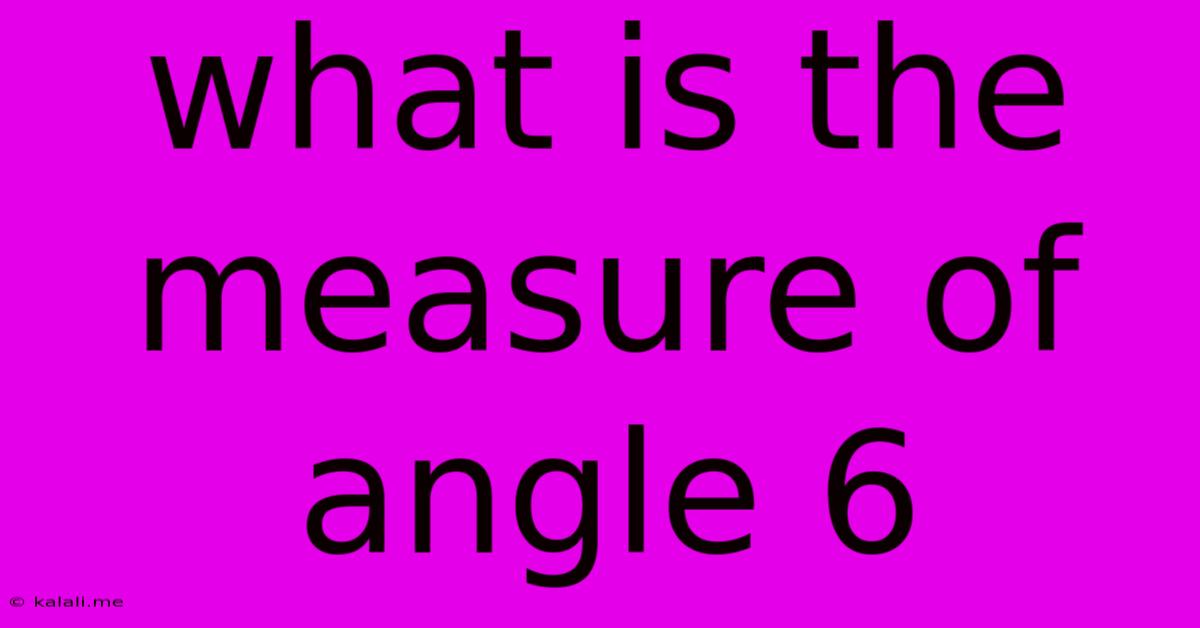What Is The Measure Of Angle 6
Kalali
Jun 15, 2025 · 3 min read

Table of Contents
What is the Measure of Angle 6? Unlocking Geometric Relationships
This article will guide you through determining the measure of angle 6, focusing on the underlying geometric principles and problem-solving strategies. We'll explore different scenarios and demonstrate how to find the answer, regardless of the provided diagram. Understanding angles, parallel lines, and transversals is crucial for success.
Understanding the Context: We Need More Information!
The question "What is the measure of angle 6?" is incomplete without a diagram showing the relationship between angle 6 and other angles. Angle 6's measure depends entirely on its context within a larger geometric figure. Is it part of a triangle? Are parallel lines and transversals involved? Does the diagram include any known angle measurements?
To effectively solve for the measure of angle 6, we need visual information. Let's explore some common scenarios:
Scenario 1: Parallel Lines and a Transversal
This is a frequently encountered geometric configuration. Imagine two parallel lines intersected by a transversal line. This creates eight angles, and several relationships exist between them:
- Corresponding Angles: Angles that are in the same relative position at an intersection are congruent (equal).
- Alternate Interior Angles: Angles that are on opposite sides of the transversal and inside the parallel lines are congruent.
- Alternate Exterior Angles: Angles that are on opposite sides of the transversal and outside the parallel lines are congruent.
- Consecutive Interior Angles: Angles that are on the same side of the transversal and inside the parallel lines are supplementary (their sum is 180°).
If angle 6 is part of such a configuration, and we know the measure of one of its related angles (corresponding, alternate interior, alternate exterior, or consecutive interior), we can easily calculate the measure of angle 6 using these relationships. For example, if we know a corresponding angle to angle 6 is 70°, then angle 6 is also 70°. If we know a consecutive interior angle is 110°, then angle 6 is 180° - 110° = 70°.
Scenario 2: Triangles
If angle 6 is an interior angle of a triangle, we can use the triangle angle sum theorem. This theorem states that the sum of the measures of the three interior angles of any triangle is always 180°. If we know the measures of two other angles in the triangle, we can subtract their sum from 180° to find the measure of angle 6.
Scenario 3: Other Polygons
Similar principles apply if angle 6 is part of other polygons. The sum of the interior angles of a polygon with 'n' sides is given by the formula (n-2) * 180°. However, knowing this sum alone isn't enough; we'd also need the measures of other angles in the polygon.
Scenario 4: Angle Relationships within a Single Line
Angle 6 might be formed by intersecting lines. In this case, adjacent angles on a straight line are supplementary (add up to 180°), and vertically opposite angles are congruent.
In Conclusion:
Determining the measure of angle 6 requires understanding its geometric context. Knowing whether it's part of parallel lines and a transversal, a triangle, another polygon, or simply intersecting lines is critical. Once you identify the relevant relationships (corresponding angles, alternate interior angles, triangle angle sum, supplementary angles, etc.), you can apply the appropriate theorems and principles to solve for the unknown angle. Remember to always analyze the diagram carefully and identify all given information before attempting a solution.
Latest Posts
Latest Posts
-
A Modulator Demodulator Is Better Known As A What
Jun 15, 2025
-
Which Of The Following Pollutants Causes Artificial Eutrophication
Jun 15, 2025
-
A Car Travels S Kilometers In 6 Hours
Jun 15, 2025
-
Lcm Of 3 6 And 9
Jun 15, 2025
-
What Is The Opposite Of Obedient
Jun 15, 2025
Related Post
Thank you for visiting our website which covers about What Is The Measure Of Angle 6 . We hope the information provided has been useful to you. Feel free to contact us if you have any questions or need further assistance. See you next time and don't miss to bookmark.